Recovery is notoriously difficult to measure and estimate. Some people need hours, others days. Fortunately we have a proxy measure called EPOC (excess post-exercise oxygen consumption). EPOC is the elevation in oxygen consumption (aka Resting Energy Expenditure) which occurs after exercise as the body recovers, repairs, and returns to its pre-exercise state. It is also known as “afterburn” although some people limit “afterburn” to immediate recovery, rather than long term recovery. Also it really applies to recovery in all fuels (ie total metabolism) not just oxygen debt.
Originally EPOC was conceived as physiological measure ie the amount of oxygen consumed in excess after exercise as measured in liters or ml/kg. This can happen for hours or days and can result in an extra 25–40% more calories burned few long term studies have been published (Falcone et al., 2015) and the longer you look, the smaller the effect then the harder it is to measure.
In studies EPOC duration ranges from 2 to 72 hours depending on type of exercise with an typical EPOC around 15–20% excess. So let us say you burned 600 calories in 1 hour of moderate workout. Another 600 x 0.15 =90 calories are burnt.

Twice a week that adds up to you 9,500 extra kilocalories over a year <> or 1.5 kilograms of body fat. However as we will see it is a highly personalized measure; meaning “15% excess” is meaningless in the real world.
===== EPOC and Body Temp =====
EPOC can be visualized by looking at core body temp during and after exercise. As we covered previously core temp (and muscle temp and skin temp) rapidly increases 1°C to 2°C during exercise, especially intensive exercise at or near VO2 max. EPOC is show in red below, and is the excess energy spend above baseline.
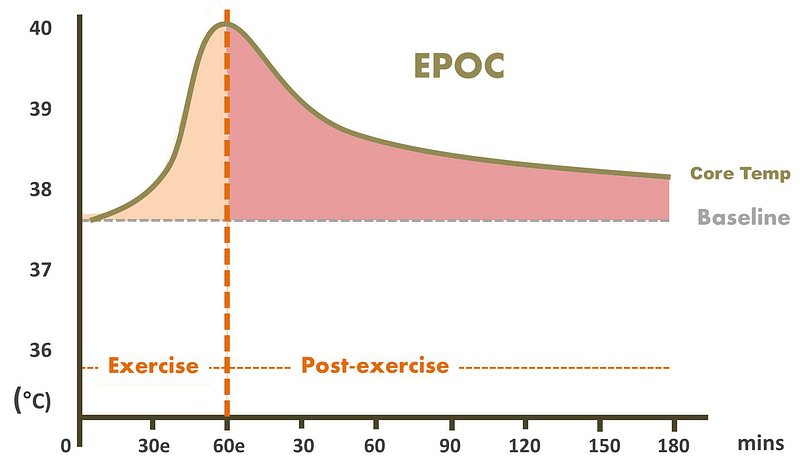
After exercise core temp falls in a gradual way, such that even hours after exercise core temp may still be elevated 0.3-0.5°C.
Kenny 2002 (LINK) found esophageal temperature was elevated by 1°C and 2°C above baseline for moderate and intense exercise trials, respectively. Kenny (LINK) also found only 53% of the heat stored during 60 min of exercise was dissipated within 60 min of recovery, with the majority of residual heat stored in muscle tissue.
So how long does this temp elevation continue? The annoying answer is “it depends”. Certainly thermoregulatory restoration after exercise may take >5x times longer than the duration of the exercise bout and is dependent upon a lot of factors. An example is outside temperature…..
===== EPOC and Environmental Temp =====
EPOC (at least as measured by body temp) is influenced by outside temp. Quindry (2013) asked 12 cyclists to complete a 1hr exercise session at 40% relative humidity in warm in three temps: (33 °C), cold (7 °C), and room-temperature environments (20 °C) . This was the result:
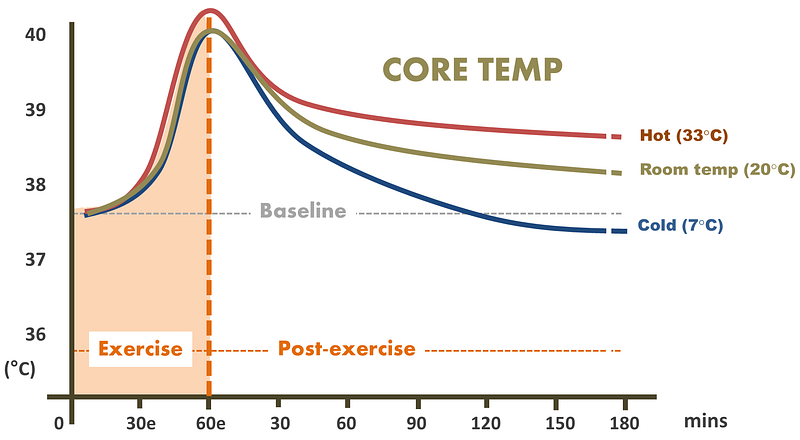
As you see, in normal or hot conditions body temp stays elevated hours after exercise. However this is only a proxy of total EPOC, studies have shown that most heat is stored in the active as well as the inactive muscles and not in the core itself.
The next logical question is why? Why does EPOC occur at all….why doesn’t the body restore homeostasis within mins or hours?
===== Why does EPOC occur? =====
After exercise, the body will recover in two main phases A: fast phase of initial replenishment of spent resources and B: Slow phase of growth aka supercompensation which is how your body gets ready to do the same again. The second time, your body will be more prepared!
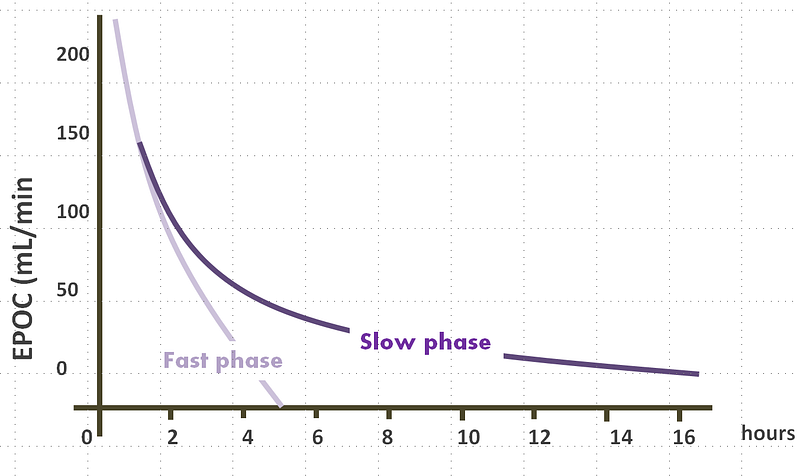
Initial fuels that were burned have to be re-made from long term stores, such as fat, liver glycogen (as well as from new food consumption). Of course it takes energy to
Regulate temperature, breathing, heart rate, and hormone levels
re-synthesize muscle glycogen from liver glycogen
re-synthesize muscle triglyceride from free fatty acids
Re-oxygenate myoglobin in muscles + hemoglobin in the blood
Replenish fluids in body tissues after sweating
Remove/convert metabolic byproducts (such as lactate, carbon dioxide)
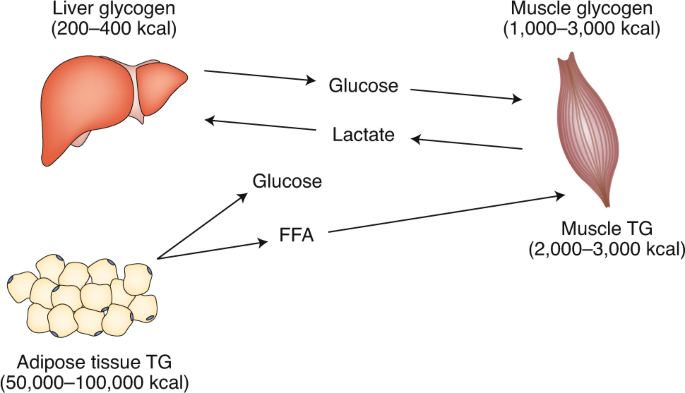
The growth phase is too complicated to cover here, but will involve protein synthesis (beginning the repair process of muscle fibers by shuttling amino acids to the muscles and assembling proteins), changes to heart structure to enhance stroke volume, and changes to blood composition.
===== How is EPOC Measured? =====
What we really want to know is what is the energy cost of exercise when we include the direct energy spent and the supercompensation effects?
One way to investigate is via indirect calorimetry although this only measures initial Energy expenditure (EE). It is calculated by measuring the amount of oxygen used and carbon dioxide released (VCO2) by the body. The ratio of CO2 produced to O2 consumed is called the Respiratory Exchange Ratio (RER) and is measured by the gas exchange. During carbohydrate metabolism, there is an equal amount of CO2 produced for O2 consumed (RER = 1.0). During fat metabolism, there is less CO2 produced for O2 consumed so a higher intensity exercise requires carbohydrates as the primary substrate, thus a higher RER indicates higher intensity and EPOC.
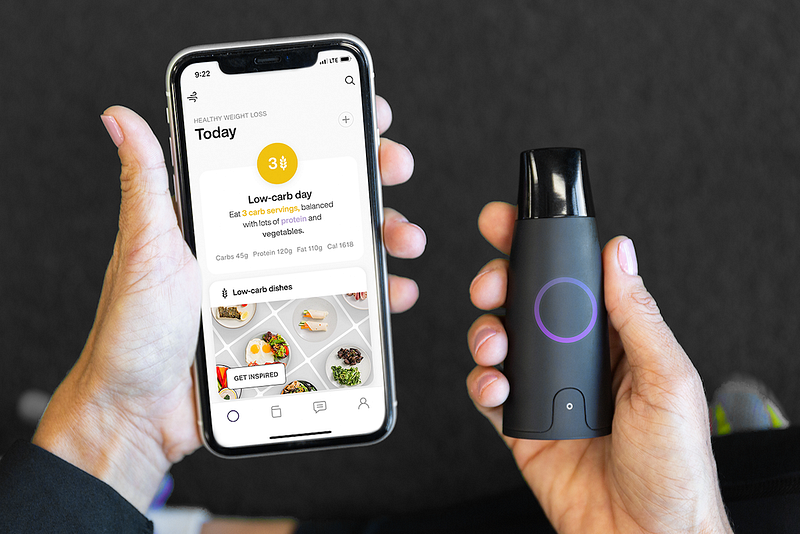
Previously this was lab based, but a number of home machines are available. EPOC can be estimated by subtracting the area under resting VO2 from the area under the recovery VO2 curve using this formula from Firstbeat
EPOC = VO2 recovery x time to recover) — (resting VO2 x time to recover)

If we use the FirstBeat equation we can plot something like this for an EPOC score riding X? mins in each power zone. EPOC scores < than 100 is slight, more than 300 is moderate, > 500 is high.


===== EPOC and Exercise Type=====
High EPOC-values are typically attained in exercise where cardiorespiratory load and oxygen consumption remain at high level without possibility to recover. Exercise that recruits large muscle mass, such as cross-country skiing and running, results in higher EPOC values than exercise that recruits small muscle mass eg walking. High EPOC values are also gained in intermittent exercise, such as interval training, soccer or squash, if recovery periods are short and intensity remains moderate.

So let us look for studies comparing three types of cycling, steady-state vs HIIT vs Sprint HIT. Tucker et al. identified an EPOC EE of ~83 kcal after four bouts of cycling at 95% peak heart rate for 4 minutes with 3 minutes of active recovery. This EE accounted for ~25% of the total EE of exercise after HIT and 41% after SIT even at 3 hours (which may not have captured the full EPOC duration).
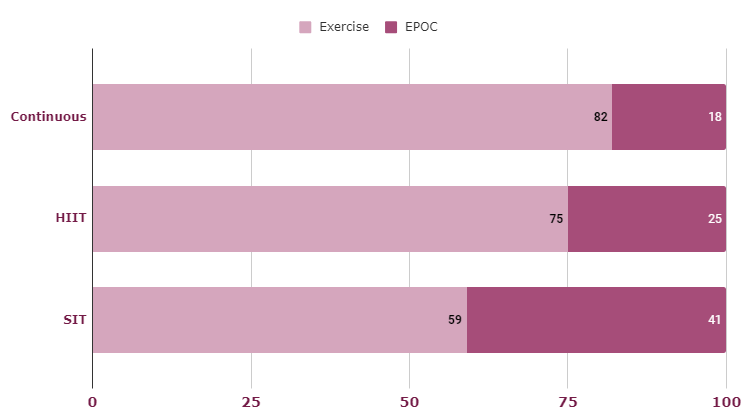
Looking at gym work, Hackney et al. (2008) found elevated EPOC to 72 hours with resting EE elevated by ~9% (550 kcal) as a result of eccentric-based training targeting increased muscular damage.
Looking at running, significant EPOC was found by Withers following athletes doing a 35km road run (70% of VO2max for 160m): EPOC was equal to 32.4L of oxygen, lasting for a total of 8 hours
===== Summary =====
EPOC is essentially the energy taken to recover after exercise back to baseline. It is more useful to look at exercise in terms of overall fuel deficit rather than oxygen debt. The higher the exercise the greater the depletion of your finite fuel stores, such as carbohydrate and creatine phosphate, leading to a greater reliance on fuel switching post-exercise to pay this back.
However it is variable and hard to quantify precisely.
- Hard prolonged exercise increases EPOC
- Exercise intensity is much more important than duration
- EPOC’s maximum limit is hard to measure and very likely underestimated
- Excess energy burn may be as little as 2% but as high as 40% with mean figures essentially meaningless *because this is personalized to the exercise you just did*
===== Citations =====
Falcone PH, Tai CY, Carson LR, Joy JM, Mosman MM, McCann TR, Crona KP, Kim MP, Moon JR. Caloric expenditure of aerobic, resistance, or combined high-intensity interval training using a hydraulic resistance system in healthy men. J Strength Cond Res. 2015 Mar;29(3):779–85.
Foureaux, G., Pinto, K. M. D. C., & Dâmaso, A. (2006). Effects of excess post-exercise oxygen consumption and resting metabolic rate in energetic cost. Revista Brasileira de Medicina do Esporte, 12(6), 393–8.
Gupta, R. D., Ramachandran, R., Venkatesan, P., Anoop, S., Joseph, M., & Thomas, N. (2017). Indirect Calorimetry: From Bench to Bedside. Indian journal of endocrinology and metabolism, 21(4), 594–599.
Hackney KJ, Engels HJ, Gretebeck RJ. Resting energy expenditure and delayed-onset muscle soreness after full-body resistance training with an eccentric concentration. J Strength Cond Res. 2008;22(5):1602–9.
Tucker WJ, Angadi SS, Gaesser GA. Excess postexercise oxygen consumption after high-intensity and sprint interval exercise, and continuous steady-state exercise. J Strength Cond Res. 2016;30(11):3090–7.
Withers RT, Gore CJ, Mackay MH, et al. Some aspect of exercise a 35 km road run. Eur J Appl Physiol 1985 Nov; 42 (5): 764–8
